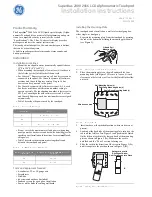
10
11
INSTaLLaTIoN aND oPeraTIoN MaNUaL SoLar MoDULeS GeNeraTIoN 3 (G3) – HaNWHa Q CeLLS aUSTraLIa PTY LTD
INSTaLLaTIoN aND oPeraTIoN MaNUaL SoLar MoDULeS GeNeraTIoN 3 (G3) – HaNWHa Q CeLLS aUSTraLIa PTY LTD
Module Selection
For detailed key electrical data, please refer to the
product data sheet for the respective product.
Ä
only connect modules of the same type and the same
power class.
Safety factor
During normal operation, a module may generate a greater
current and / or higher voltage than that determined under
standardised test conditions.
Refer to As / NZs 5033:2012 (including all relevant
amendments) and the clean energy council Guidelines
(for Australia).
Series Connection
connection of modules in series is only permitted up to
the maximum system voltage as listed in the applicable
data sheet.
Ä
take into account all possible operating situations and all
relevant technical norms and regulations when designing
the system. this will ensure that the maximum system
voltage, including all necessary safety margins, is not
exceeded.
Ä
take the voltage limit of the inverter into account when
determining the maximum number of modules in the
string.
Parallel Connection
modules may be damaged by the occurrence of reverse
currents (caused by module defects, ground leaks, or
defective insulation).
Ä
ensure that the maximum reverse current load capacity
indicated in the data sheet is observed.
in order to limit reverse currents that may occur, we
recommend using the following safety options:
1) Layout with a limited number of parallel connected
strings :
Refer to As / NZs 5033:2012 (including all relevant
amendments) for parallel string overcurrent protection
requirements.
2) Layout with string fuses :
place fuses for each string of modules at the plus and
minus ends. observe the maximum permitted number
of strings as indicated in the specifications provided by
the respective string fuse manufacturer and the technical
guidelines.
NOTE!
When installing different product versions, the lowest
minimum permitted reverse current load capacity applies.
Inverters
inverters with or without transformers may be used.
2.4 electrical layout
2 PLaNNING
2 PLaNNING
2.3 Mounting options
SPeCIfICaTIoN of THe CLaMPING raNGe
Ä
in case of varying clamping range for push and pull loads the smaller clamping range must be applied.
DISTaNCe BeTWeeN MoDULeS
Ä
maintain an interval of at least 10 mm between two modules.
MoUNTING oPTIoN CL1
Ä
ensure, that the subconstruction does not run below the junction box.
MoUNTING oPTIoN CL4
Ä
ensure, that the subconstruction runs exactly below the frame, not below the laminate (module less frame).
MoUNTING oPTIoNS fB1 aND fB2
•
the fastening points are located on the backside of the module frame.






























